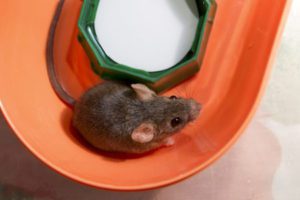“HELP! I THINK THERE’S A MOUSE IN THE HOUSE!”
By Zachary Ciras on January 5, 2021.
Just when we’re all cooped up in the house, I think a mouse has joined us! My wife found a strange bundle of fluff and debris in the back of the kitchen pan drawer. Is that a mouse nest? And either we’re finally going nuts or there is actually a strange sort of squeaking sound that we hear at night. Mice?
D.Z. Ipswich, MA
Sorry to be the bearer of bad news but both found nest material and strange sounds are indeed signs of mice. Of course they could be signs of other things, too. A pest management professional can make the determination.
 There are several more signs of the presence of mice. The more that you discover, the more likely you have mice living in your home. Having signs of mice doesn’t mean that you have an active infestation, however. Some evidence could be old. Again, this is where a rodent inspection by a professional is invaluable. Plus, if a pest control professional does find mice in your home, control options are readily available.
There are several more signs of the presence of mice. The more that you discover, the more likely you have mice living in your home. Having signs of mice doesn’t mean that you have an active infestation, however. Some evidence could be old. Again, this is where a rodent inspection by a professional is invaluable. Plus, if a pest control professional does find mice in your home, control options are readily available.
SIGNS THAT YOU MAY HAVE A MOUSE INFESTATION
The mouse evidence given below generally applies to both house mice and deer mice. Either one can be found indoors in our region.
Nest Material
A female mouse’s nest is a loose clump of miscellaneous soft materials. It’s about the size of a grapefruit but is rarely uniform in shape and may be elongated to fit the site. Nests are located near a food source, at ground level, often in dark, undisturbed corners or voids.
The mouse will use whatever is easily available for nest material: shredded paper or fabric, string, yarn, bits of facial tissue or paper towel, leaves, dried plants, bits of insulation, fur, dryer lint, etc. You might find bits of seeds, nuts, stolen dry pet food, or other hoarded food in or near the nest. You also may find mouse poop (black, ¼-inch, spindle-shaped droppings) in the nest.
For more on mouse nests: Could You Recognize a Mouse Nest?
Mouse Poop
In the business, we call these mouse “droppings,” maybe because a single mouse produces so many (70 per day) and leaves them, a few at a time, in lots of random places. For this reason, mouse droppings are often the first sign of a mouse problem. If you haven’t seen droppings, it may be because they are primarily in a wall void or inside cabinets. Or, maybe your mouse infestation is so new that noticeable droppings haven’t yet accumulated. It’s important to be able to recognize the difference between old droppings and fresh droppings to help determine whether you have an active infestation.
For more on mouse droppings: All About Mouse Poop!
Mouse Holes or Gnawing Damage
Mice will chew to enlarge too-small openings so that they can get to food or nest sites. They chew at the bottom corners of doors so they can squeeze through when the door is shut. They enlarge openings around pipes or cables so they can fit through the gap and then use these conduits as travel routes. And, they often just gnaw on things because they feel like it!
For more: Property Damage From Mice
Other Miscellaneous Signs of Mice
Other signs that may be apparent when mice are present are (1) surprise stashes of hoarded food (pet food, birdseed, nuts) in hidden places such as wall voids or boxes, (2) scratching, scrambling, or squeaking sounds, (3) dark, greasy “rub marks” along surfaces that mice frequently touch, (4) mouse urine odors, or (5) decay smells from dead mice.
For more detailed information on these telltale signs of mice, see How Do I Know if I Have a Mouse Problem?, then contact Colonial Pest Control before a single mouse becomes many!